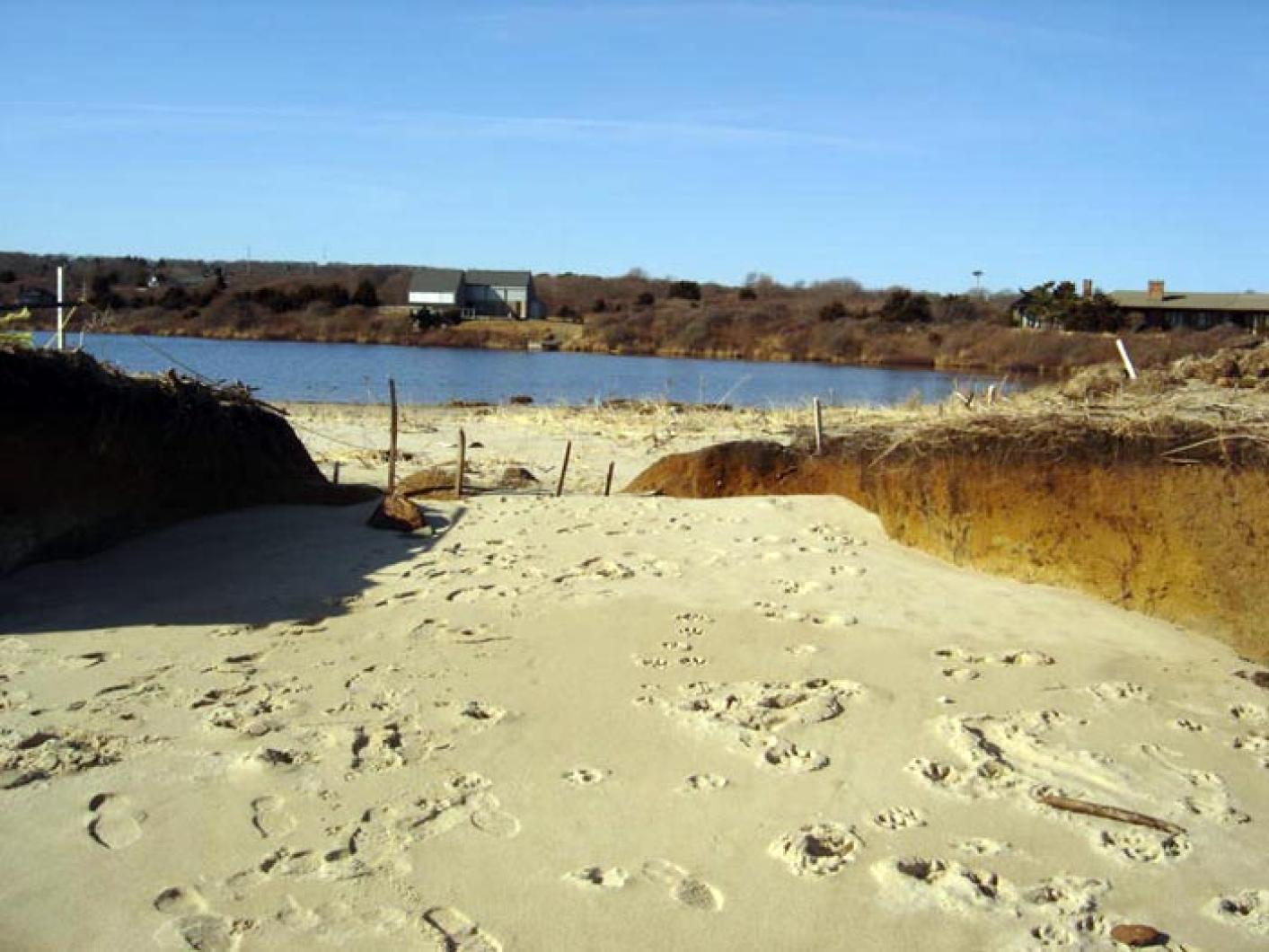Three days ago, The Trustees of Reservations staff removed the last of the big old telephone poles delineating the parking lot at Wasque Point on Chappaquiddick, lest they lose them to the sea.
A week or so from now, the remaining half of the parking lot will probably be gone; the shoreline at Wasque has retreated almost 100 feet since early November, and continues to erode at a rate of about one foot per day.
How long might this go on?
“Who knows,” said Chris Kennedy, The Trustees’ Martha’s Vineyard superintendent. “A year from now? Five years from now?”
Meanwhile, 10 miles or so along the Vineyard’s south shore, part of the track to the eastern section of Lucy Vincent beach is gone, eaten up by the Atlantic.
“It’s been ferocious this winter. I’ve never seen erosion so dramatic,” said Kristin Maloney, chairman of the Chilmark beach committee.
“I mean, we get a bit of wash-over every winter, but it doesn’t completely break the dunes down like it has this year. The dunes are basically gone in one section. A little beach is being created in the pond behind.”
Already Lucy Vincent is essentially two beaches, separated by the crumbling cliffs.
“And there’s now a big cave in the cliffs there. That’s going to be really dangerous, because kids of course will want to walk in there,” she said.
“And it’s been bad all the way down the Windy Gates side too.”
You get the picture here: even by the usual standards of Martha’s Vineyard’s constantly changing shoreline, this has been a dramatic winter.
As to why it has, different people attribute it to different causes.
In the case of the erosion at Wasque, Mr. Kennedy blames the breach in Norton Point beach, caused by a big storm four years ago.
Since that storm, the breach has moved slowly eastwards, as sand has been deposited on one side and removed from the other. Now the tidal flows through the gap are tearing at Wasque.
“As long as that concentrated current is forced against the shoreline, we’re going to see massive erosion,” he said.
“We think we won’t see much accretion of sand until the breach closes,” said Mr. Kennedy. “And who knows when that might be.”
On the upside, he said, it seems at least some of the sand being taken from Wasque, along with trees and bushes plucked from the cliffs, is being redeposited around the corner on the east-facing beaches of Chappaquiddick.
Elsewhere on the south shore, he said, things were more typical of the seasonal changes which happen every year; there is erosion in winter and deposition when the wind changes to the southwest in spring and summer.
“At our Long Point property we have a typical winter beach profile. At high water the waves are pounding right up against the dunes,” he said.
Ms. Maloney, however, says what she has seen over recent months is not typical.
“The ocean’s definitely rising, I think. Some of these changes look permanent to me. Even during high tide in winter storms, it has never come in that far before.
“The sand will come back in summer, but there’s definitely less beach than there used to be.”
Of course, even the scientists who warn about climate change also warn against attributing any single event to the phenomenon.
So does Reid Silva, owner of Vineyard Land Surveying and Engineering, who has studied the data on coastal erosion on the Vineyard over many years.
The long-term patterns, however, are undeniable — the Vineyard is washing away at a pretty rapid rate. On average, the south shore is retreating about seven feet a year, more in some places than others and more in some years than others.
“And there are big variations, and some years look extreme compared with others,” he said.
“A large section of cliff — 40 or 50 feet — might suddenly collapse one year, and then it could take several years for the fallen material to be washed away before the sea once again begins undermining the next section of cliff.”
As to what climate change, a sea level rise of three or six inches, more frequent and intense storms might do to the rates of erosion, he says, “There’s a lot of questions” yet to be answered.
But for south shore property owners, those questions are pretty vital. A number of houses already have had to be moved back from the edge, he said. A couple have even been specially designed on beams so they can be moved as the shoreline retreats.
“Erosion is going to continue. There’s a lot of valuable houses on [the south shore of] the Island that are going to be threatened. And in the Squibnocket area in particular, there is not much room to move back in a lot of cases,” he said.
Which is tough for them. But Chris Kennedy looks at the dynamic nature of the Vineyard shoreline in a more sanguine way.
“This is a place of tremendous change, and I think that is one of the things that makes living on the Vineyard so wonderful. You always have a different landscape to view, depending on the season,” he said.
The fact is, Martha’s Vineyard is a very temporary land form, which has been eroding since the last ice sheet retreated only 25,000 years ago.
“Sooner or later we are all going to have waterfront property, said Mr. Kennedy.







Comments
Comment policy »